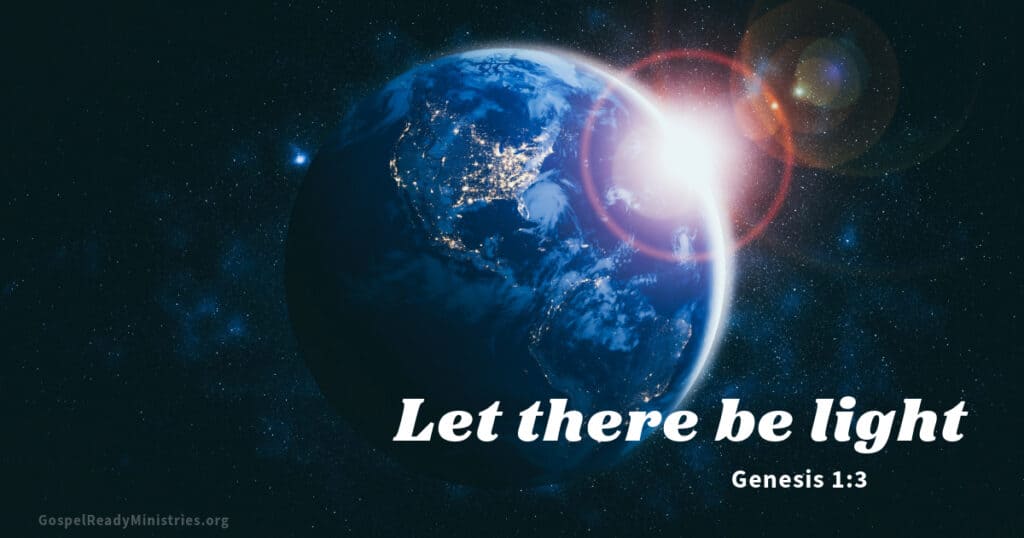When I young child, people would say “Let there be light” when they flipped on a light switch or plug in the lights of a Christmas tree. I just thought it had to do with the actual lights you were turning on. As I got older, I became aware that the saying had something to do with God being the one who said, “let there be light”. After becoming a Christian, I learned that there is more to the saying than just what God said. I learned about the creation story. How much do you know about the creation story?

What happened on the first day of creation?
On the first day, God created the heavens, earth, and light. God showed His unique ability to create from nothing. These creations are different than you perceive them today. The heavens were empty: no sun, moon, or stars. The earth was formless and void: no plants, animals, people, or even land.
There was no light until God spoke it into existence later. It was unlike any light we know of today. This light had no source. God just spoke the words “Let there be light” and the light came into being.
In the beginning, God created the heavens and the earth. The earth was without form and void, and darkness was over the face of the deep. And the Spirit of God was hovering over the face of the waters. And God said, “Let there be light,” and there was light. And God saw that the light was good. And God separated the light from the darkness. God called the light Day, and the darkness he called Night. And there was evening and there was morning, the first day.
Genesis 1:1-5
These are just five verses, but there is a lot we can learn from them. Read on and learn more.
How long was a day in creation?
The description of each day of creation ends the same way: “And there was evening and there was morning, the __ (1st, 2nd, 3rd, etc.) day.” Since the introduction of the theory of evolution, some scholars argue that this could just mean a long period of time. However, the historical view of theologians is that the days of creation are literal 24-hour periods. There are many reasons to believe this is true. I will mention two of them here.
The days are described as having evening and morning, which constitutes an entire day. The Hebrew words used were dusk (or night) and dawn (or day). So, the pattern would be a time of work, followed by night, and then finally morning. In this way, Moses was explaining each day in a way that the Israelites would understand.
Another reason to understand these as 24-hour days is the same words are used in other places in scripture to mean literal days. For example, the Ten Commandments instructed the Israelites to do all their work in 6 days and then keep the Sabbath on the 7th day. This was understood as a traditional week, consisting of 7 24-hour days.
What was the earth like when it was first created?
When first created, the earth was without form and void.

The only separation was between the heavens, space, and the earth. The earth itself is described as the deeps, or waters, with the Spirit of God hovering over it. There was simply space and the earth.
The sky, or atmosphere, came into existence on day 2. Dry land didn’t come into existence until day 3.
So, close your eyes and picture a planet of just deep waters within the emptiness of space. Now image, God says, “Let there be light”, and suddenly light just appears.
So, close your eyes and picture a planet of just deep waters within the emptiness of space. Now image, God says, “Let there be light”, and suddenly light just appears.
Since there is no sun yet, where did light come from?
When God speaks light into existence, it creates separate periods of light and dark. The word used means illumination or light itself. The sun doesn’t exist until day 4. So, it is light without a source, manifested by God.
When did creation happen?
The very first words of Genesis are “In the beginning”. This phrase is given as being before anything was created. Even space did not exist. There was only God.
Unlike any other living thing, God needs nothing to continue being. He needs no warmth, no food, no water, or anything else. God is self-existent, which is a foundational characteristic which helps us understand who God is.
What Does the Name Yahweh Tell Us About God?
Then Moses said to God, “If I come to the people of Israel and say to them, ‘The God of your fathers has sent me to you,’ and they ask me, ‘What is his name?’ what shall I say to them?” God said to Moses, “I AM WHO I AM.” And he said, “Say this to the people of Israel: ‘I AM has sent me to you.'”
Exodus 3:13-14
In Exodus 3, Moses is at the burning bush. It is here that God tells Moses to go to the Pharoah in Egypt in order to bring the Israelites about of captivity.
Moses asks what God’s name is so the Israelites will believe him. In response, God says that His name is Yahweh. In Hebrew, this would have been written as YHWH. In verse 14, this is a form of the Hebrew verb, hayah, which means “to be”.
In English, it would be translated as I AM WHO I AM (or more simply as I AM). I love how His name reflects His self-existence. God existed before all things, and without needing anything to continue existing.
